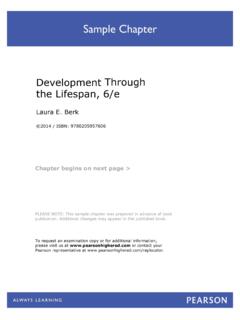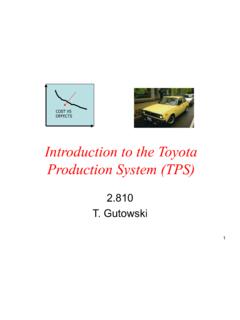Transcription of 10 Reactions of Alcohols, Ethers, Epoxides, Amines, and
1 458 Reactions of Alcohols, Ethers, Epoxides, Amines, and Sulfur-Containing Compounds10 Chemists search the world for plants and berries and the ocean for flora and fauna that might be used as the source of a lead compound for the development of a new drug. In this chapter, we will see how cocaine, which is obtained from the leaves of Erythroxylon coca a bush native to the high-lands of the South American Andes, was used as the source of a lead compound for the development of some common anesthetics (see page 491).We saw that alkyl halides, a family of compounds in Group II, undergo substitution and/or elimination Reactions because of their electron-withdrawing halogen atoms (Chapter 9). Other families of compounds in Group II also have electron-withdrawing groups, and they too undergo substitution and/or elimination Reactions .
2 The relative reactivity of these compounds depends on the electron-withdrawing group that is, on the leaving Depends on the Basicity of the Leaving Group The leaving groups of alcohols and ethers (HO-, RO-) are much stronger bases than the leav-ing group of an alkyl halide. Because they are stronger bases, they are poorer leaving groups and, therefore, are harder to displace. Consequently, alcohols and ethers are less reactive than alkyl halides in substitution and elimination Reactions . We will see that alcohols and ethers must be activated before they can undergo a substitution or elimination reaction. The leaving group of an amine (-NH2) is so basic that amines cannot undergo substitution and elimination Reactions but they are important bases and coca leavesalkyl halidealcoholetherepoxideGroup IIRXROHRORORRX = F, Cl, Br, Isulfonateestersulfoniumionquaternaryamm oniumhydroxideROSOORRSRRRR HO NRR++ 45818/09/15 12:05 pm Nucleophilic Substitution Reactions of Alcohols: Forming Alkyl Halides 459 Tertiary amines, the leaving groups of quaternary ammonium ions, not only are less basic than the leaving groups of alcohols and ethers but also have a positive charge that enhances their leaving ability.
3 Therefore, quaternary ammonium ions undergo elimination Reactions as long as a strong base is present and the reaction is heated. Sulfonate esters and sulfonium ions have very good leaving groups, the first because of electron delocalization and the second because of its positive charge. Thus, they undergo substitution and/or elimination Reactions with ionetheralcoholalkyl halideX = F, Cl, Br, IROR amineRNH2 RSRR+NRRRR+quaternaryammonium ionpKa of conjugateacid of the leavinggroup 10 to 15 15 1040sulfonate esterROSOOR 6 NucLeophiLic SuBStitutioN Reactions of aLcohoLS: foRmiNG aLkyL haLiDeSAn alcohol has a strongly basic leaving group (HO-) that cannot be displaced by a nucleophile.
4 Therefore, an alcohol cannot undergo a nucleophilic substitution strong base+HO +OHa strongly basic leaving groupHowever, if the alcohol s OH group is converted into a group that is a weaker base (and, therefore, a better leaving group), a nucleophilic substitution reaction can an oh Group into a Better Leaving GroupOne way to convert an OH group into a weaker base is to protonate it by adding acid to the reaction mixture. Protonation changes the leaving group from HO- to H2O, which is a weak enough base to be displaced by a nucleophile. The substitution reaction is slow and requires heat (except in the case of tertiary alcohols) if it is to take place at a reasonable +H2O+Br weak base HCH3 HCH3 Bra weakly basic leaving grouppoor leavinggroupgood leavinggroupOO+HBecause the OH group of the alcohol must be protonated before it can be displaced by a nucleo-phile, only weakly basic nucleophiles (I-, Br-, Cl-) can be used in the substitution reaction.
5 Moderately and strongly basic nucleophiles (NH3, RNH2, and CH3O-) cannot be used because they too would be protonated in the acidic solution and, once protonated, would no longer be nucleo-philes (+NH4, RN+H3) or would be poor nucleophiles (CH3OH).When bases with similar features are compared: the weaker the base, the more easily it is displaced. Recall that the stronger the acid, the weaker its conjugate 1 Why are NH3 and CH3NH2 no longer nucleophiles when they are protonated? 45918/09/15 12:05 pm460 ChAptER 10 Reactions of Alcohols, Ethers, Epoxides, Amines, and Sulfur-Containing CompoundsPrimary, secondary, and tertiary alcohols all undergo nucleophilic substitution Reactions with HI, HBr, and HCl to form alkyl +H2O+HBr+H2O+Brprimary alcoholsecondary alcohol tertiary alcoholCH3 CCH2CH3 HBrCH3OH+CH3 CCH2CH3H2 OCH3Br+the SN1 Reaction of Secondary and tertiary alcoholsThe mechanism of the substitution reaction depends on the structure of the alcohol.
6 Secondary and tertiary alcohols undergo SN1 FOR THE SN1 REACTION OF AN ALCOHOLCH3 COHHHBrCH3CH3+H2O++ CH3 CHCH3CH3CH3 CBrCH3CH3CH3C+CH3CH3CH3 CCH3 HBrCH2 Brelimination productsubstitutionproduct H+reaction of the carbocationwith a nucleophilethe acid protonatesthe most basic atoman alkene productundergoes anaddition reactionformation ofa carbocation+O An acid always reacts with an organic molecule in the same way: it protonates the most basic atom in the molecule. Weakly basic water is the leaving group that is expelled, forming a carbocation. The carbocation, like the carbocation formed when an alkyl halide dissociates in an SN1 reaction, has two possible fates: it can combine with a nucleophile and form a substitution product, or it can lose a proton and form an elimination product (Section ).
7 Although the reaction can form both a substitution product and an elimination product, little elimination product is actually obtained because the alkene formed in an elimination reaction can undergo a subsequent electrophilic addition reaction with HBr to form more of the substitution product (Section ).Tertiary alcohols undergo substitution Reactions with hydrogen halides faster than secondary alcohols do because tertiary carbocations are more stable and, therefore, are formed more rapidly than secondary carbocations. (Recall that alkyl groups stabilize carbocations by hyperconjugation; Section ) As a result, the reaction of a tertiary alcohol with a hydrogen halide proceeds readily at room temperature, whereas the reaction of a secondary alcohol with a hydrogen halide must be heated to have the reaction occur at a reasonable acid protonates the most basic atom in a 46018/09/15 12:05 pm Nucleophilic Substitution Reactions of Alcohols: Forming Alkyl Halides 461the SN2 Reaction of primary alcoholsPrimary alcohols cannot undergo SN1 Reactions because primary carbocations are too unstable to be formed, even when the reaction is heated (Section ).
8 Therefore, when a primary alcohol reacts with a hydrogen halide, it must do so in an SN2 FOR THE SN2 REACTION OF AN ALCOHOL a primary alcoholCH3CH2 OHCH3CH2CH3CH2 BrHBrH+H2O++ BrOHthe acid protonatesthe most basic atomback-side attack bythe nucleophileelectrophile The acid protonates the most basic atom in the reactant. The nucleophile attacks the back side of the carbon and displaces the leaving a substitution product is obtained. No elimination product is formed because the halide ion, although a good nucleophile, is a weak base in a reaction mixture that contains alcohol and water (that is, in a polar protic solvent). Recall that a strong base is required to remove a hydrogen from a b-carbon in an E2 reaction (Section ).
9 When HCl is used instead of HBr or HI, the SN2 reaction is slower because Cl- is a poorer nucleophile than Br- or I- (Section ). However, the rate of the reaction can be increased if ZnCl2 is used as a +H2O+ ZnCl2 is a Lewis acid that complexes strongly with oxygen s lone-pair electrons. This interaction weakens the C O bond, thereby creating a better leaving group than +HOZnCl+ClOHCH3CH2CH2 ZnCl+ Secondary and tertiary alcohols undergo SN1 Reactions with hydrogen alcohols undergo SN2 Reactions with hydrogen Lucas testBefore spectroscopy became available for structural analysis, chemists had to identify compounds by tests that gave visible results. The Lucas test is one such test. It determines whether an alcohol is primary, secondary, or tertiary by taking advantage of the relative rates at which the three classes of alcohols react with carry out the test, the alcohol is added to a mixture of HCl and ZnCl2 (known as Lucas reagent).
10 Low-molecular-weight alcohols are soluble in Lucas reagent, but the alkyl halide products are not, so they cause the solution to turn cloudy. If the alcohol is tertiary, the solution turns cloudy immediately. If the alcohol is secondary, the solution turns cloudy in approximately one to five minutes. If the alcohol is primary, the solution turns cloudy only if it is heated. Because the test relies on the complete solubility of the alcohol in Lucas reagent, it is limited to alcohols with fewer than six 2 SoLveDUsing the pKa values of the conjugate acids of the leaving groups (the pKa of HBr is -9, and the pKa of H2O is ), explain the difference in reactivity between CH3Br and CH3OH in a nucleophilic substitution The conjugate acid of the leaving group of CH3Br is HBr; the conjugate acid of the leaving group of CH3OH is H2O.

















